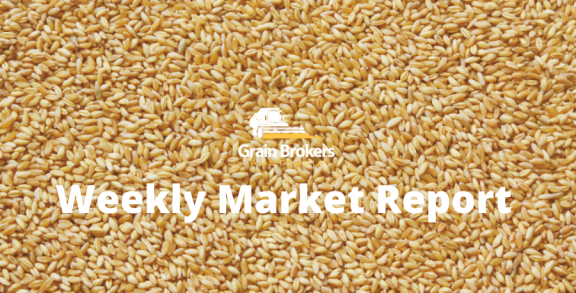
In a week when the USDA released the latest chapter in its intriguing but never-ending world agricultural supply and demand saga, it was Russia who took centre stage, confirming plans for the introduction of grain export quotas in the New Year along with possible changes to the existing export duty.
The escalation of export restrictions comes as food inflation in Russia runs at a five-year high, and global wheat prices continue to rise in a concerted effort to ration supply. The new measures are being introduced in a bid to cool inflationary pressures by boosting upcountry stocks and increasing supply to domestic consumers.
The Russian agriculture ministry’s announcement on Wednesday of last week initially led to a degree of market confusion around the actual start date of the proposed quotas, making mention of January. However, it is now believed that the finer details of the export restrictions on a range of commodities, including wheat, will be determined in December, and announced in January. The new export quotas are expected to commence on February 15, as previously mooted, and run to the end of the 2021/22 marketing year on June 30.
The size of the wheat quota will be determined by two things: final 2021/22 production and the pace of exports in the first six months of the marketing year. In late October, the Russian government reduced its wheat production estimate to 75MMT, 10MMT lower than last season. This is broadly in line with market estimates, with Sovecon at 75.5MMT, IKAR in the 75-75.6MMT range and the USDA at 74.5MMT, up 2MMT from its October forecast.
In last week’s communique, the agriculture ministry also stated the existing floating export duty formula may be modified to impose higher taxes should global wheat prices get close to the US$400 per metric tonne level. Russian 12.5 per cent protein wheat was quoted as high as US$340 free-on-board for December shipment at the close of last week, up around US$100 since the beginning of the current marketing year.
Moscow introduced the floating export tax in June of this year, with its magnitude determined by the agriculture ministry weekly. It is based on a formula that applies a 70 per cent tax to the difference between the government determined base price and the current market price. The tax is currently set at US$69.90/MT for the November 10-16 period. This will rise a further US$7.20/MT to US$77.10/MT for the week ending November 23.
If the global wheat market continues to rally, which is highly probable given the current supply and demand imbalance, and Moscow decides to tweak the formula, it has two options. It can either reduce the base price: currently US$200 per metric tonne for wheat, or it can raise the 70 per cent tax rate. Or the government could do both, I guess; such is the unpredictability of the authorities in Moscow.
The conundrum for Russia is a tightening global wheat balance sheet, clashing with a poor domestic production year. Russia has been the world’s biggest exporter of wheat in recent years. Importers want Russian grain, but the Russian farmer is refusing to sell. They know that as world wheat values rally, the exporters can pay more for their grain. Theoretically, the grower bid should be 30 cents higher for every dollar increase in the export price. But if the exporter is squeezed, it will likely be more. The Russian government gets the other 70 cents of course.
Russian wheat exports reportedly totalled 15.3MMT in the first four months of the 2021/22 marketing year, although it is difficult to get accurate and timely data. That is almost 19 per cent lower than the 18.8MMT that was shipped in the same period last season. With the export tax increasing substantially every week, wheat shipments from Russia’s Black Sea ports are already slowing.
And as the winter freeze sets in across Europe, it will be impossible to maintain the current pace of wheat exports. Even 3MMT per month would be quite an optimistic outcome and would put exports at 25.8MMT by the time the quota is introduced on February 15. When the flat export tax of US$60/MT was introduced early this year, Russia only exported 2.5MMT of wheat in the March to May period. This season the floating tax could be US$100/MT, or even more, by New Year.
The latest market talk out of Russia is a wheat export quota possibly as low as 5MMT for the February 15 to June 30 period, much smaller than earlier suggestions of 1.5MMT per month. The former would put 2021/22 exports at 30.8MMT, slightly lower than the Russian government’s export target of 31.5MMT, and the latter would put exports slightly higher at 32.6MMT by the season’s end.
However, both scenarios are still much lower than the USDA. Despite all the talk of increased export restrictions, the USDA raised its Russian wheat export forecast by 1MMT to 36MMT in last week’s monthly supply and demand update. Sovecon recently cut its Russian wheat export forecast by another 0.3MMT to 34MMT and IKAR kept its estimate unchanged, quoting a range of 31.5-32MMT.
The Russian farmer will largely determine the pace of the nation’s exports over the next three months. With new demand from global consumers surfacing every week, the world wants more from them at the moment than they are prepared to concede. And the same can be said of most of the major northern hemisphere exporters.
The market needs a widescale capitulation by the Russian farmer. Maybe a floating tax approaching US$100/MT and the prospect of an export quota may be enough to loosen their grip and entice them to sell nearby wheat ahead of the mid-February deadline.
Call your local Grain Brokers Australia representative on 1300 946 544 to discuss your grain marketing needs.





